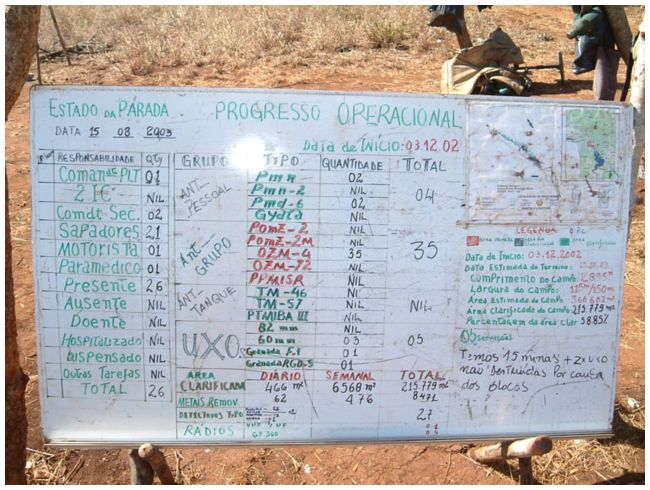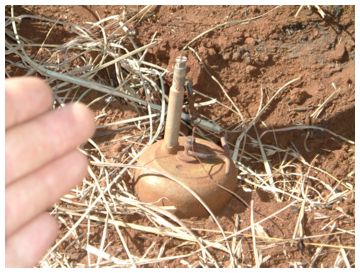Scarred by the effects of a war for independence and subsequent years of civil conflict, Mozambique is heavily contaminated by live landmines and countless unexploded ordinance (UXO). Landmines and UXO are still found daily scattered around former military installations, around towns and villages of particular strategic importance, around major infrastructure installations (including reservoirs and power lines), and around community infrastructure, including roads, railways, water points and schools. Although most areas are not heavily mined, the presence or assumed presence of landmines and UXO remains a significant obstacle to workers in the field, children at play, cattle, development and reconstruction.
The capital city of Maputo is now the home of the programme dedicated to ridding the country of this unwanted inheritance – the Accelerated Demining Programme (ADP). A UN project since 1995, the ADP operates in the three southern provinces of Inhambane, Gaza and Maputo. With nine 32 man platoon sections, four dog teams, four survey teams, two mechanical clearance teams and all the logistical, administrative and financial back up staff, they number almost 400 strong. They have equipment bought and donated from all over the world as well as foreign technical advisors to provide equipment training.
On our arrival in Maputo we met with our contact Dr Xavier and his colleague Sergio at the National Institute for Demining before being given an excellent presentation at the ADP headquarters by Assistant Director Florencio Chongo. After the presentation, we were driven to Mozambique’s south-western border with Swaziland to see a minefield currently being cleared by one platoon and a dog team.
The ADP own two mechanical deminers (large armoured remote control vehicles) but due to expense, logistics and terrain they are not accessible to all areas of operation. Hence in this minefield, the platoon rely entirely on their dogs, metal detectors and their own steady hands. Wearing a face guard and body armour from face to knee, they clear metre by metre of marked out vegetation to allow use of their metal detectors. Then hoping for a low metal content in the soil, they manually probe any find with a foot long metal rod skewered into the soil at a 45 degree angle so as not to depress any potential detonator. This is done on their knees with their face just two feet from a possible explosion. The dogs are used for ground with little or no vegetation.
When we arrived at the minefield the platoon had already been in place for 8 months, camping on site, and had cleared 58 percent of the 215,779m2 minefield. As seen on their site information board below (in Portuguese – Mozambique’s official language), in this time they had uncovered four anti-personnel mines, 35 anti-group mines, no anti-tank mines but five UXO (three 60mm shells and two grenades). Slow work but each discovery represents lives saved.
 on-site information board
on-site information board
After being
strapped into our full body armour, we were lead down paths marked out by white tape to the present operating area where the platoon were busy at work. On live ground they demonstrated their
vegetation clearance technique and
metal detecting. Then on dead ground they demonstrated their
probing of the soil. Within the dead ground area were a few of the live landmines which had been marked off in their original position. About the size of a fist and earth coloured, the landmines were hard to spot even when
marked by a skull and crossbones placard.
 a mine before being cleared,
a mine before being cleared,
dangerously hard to spot
 a cleared mine ready for controlled destruction
a cleared mine ready for controlled destruction
We also witnesses one of the twice daily
dog training exercises carried out to keep the dogs refreshed when they are not working. In a marked square of dead ground a box containing a small amount of TNT was buried randomly. Working with a handler, the dog patrolled up and down the square in columns, covering each inch with his nose to the ground. The dog found the explosive with ease, sitting down immediately to mark his find. On returning to his handler the dog was then rewarded with enthusiasm and a biscuit. Due to their light body weight and fantastic sense of smell, no dog has ever been injured on this programme.
As we were leaving we were given a brief sight of the basic camp the platoon had made their home. Out on their own for most of the year, carrying out extremely repetitive work (but never being able to allow their concentration to slip) they have the hardest job I have ever witnessed. Combined with the parallel schemes of landmine awareness and victim assistance, the ADP really is carrying out life changing work. Homes and crops have to be abandoned and people evacuated when a new minefield is discovered. This is both physically disruptive and emotionally unsettling for the local people involved but the clearance allows a safer environment and also provides room for development such as the new school in Maluana, fields for agriculture in Moamba and an aluminium smelter in Mozal.
My brother and I are still extremely grateful to have been given a driver and guide at our disposal, as well as the time for such a detailed presentation by the busy assistant director. Our massive thanks to Dr Xavier and Sergio at the IND and Florencio Chongo at the ADP in Maputo. A big thank you also to Dr Ffinlo Costain in the London office of Adopt-A-Minefield for all his help.
Such an experience has left us with life long images in our mind of the long term disruptive effects of the five minutes it takes to lay a landmine. We now know exactly how the money that you have kindly donated will be spent and can say that it is money very well placed and very much appreciated.
Thank you for all your support,
Doug and Jag Orr
BrothersOrr
Transafrica 2003

